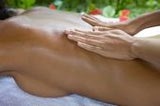Exfoliation is the removal of the oldest dead skin cells that cling to the skin’s outermost surface, or epidermis. Exfoliation is an important part of both facials and body treatments. When done correctly, exfoliation leaves the skin feeling smoother and fresher looking. Exfoliation also makes it easier for expensive facial products like serums to pentrate.
There are two forms of exfoliation:
1) Mechanical Exfoliation. The dead skin cells are physically rubbed off with an abrasive. Examples of mechanical exfoliation include a salt glow, a body scrub that might use sugar or coffee grounds, or skin brushing. On the face, scrubs should use small, round, gentle abrasives like jojoba beads. Stay away from something harsh like apricot scrubs, which can cause micro-tears in your skin. A more aggressive and effective approach to mechanical exfoliation is microdermabrasion, which comes in two types – crystal and crystal-free, or diamond-tip.
2) Chemical Exfoliation. Enzymes, alphahydroxy acids (AHAs) or betahydroxy acids (BHAS) loosen the glue-like substance that holds the cells together, allowing them to slough away. Facial peels are a form of chemical exfoliation. Chemical peels can either be very gentle or very aggressive, depending on how the strong the peel is. Body treatments might use mild chemical exfoliants like pineapple enzymes.
The skin is constantly generating new skin cells at the lower layer (the dermis) and sending them to the surface (the epidermis). As the cells rise to the surface they gradually die and become filled with keratin. These keratinized skin cells are essential because they give our skin its protective quality. But they are constantly sloughing off to make way for younger cells.
As we age the process of cell turnover slows down. Cells start to pile up unevenly on the skin’s surface, giving it a dry, rough, dull appearance. Exfoliation is beneficial because it removes those cells that are clinging on, revealing the fresher, younger skin cells below.
It is possible, however, to overexfoliate, especially on the delicate skin of the face. Overexfoliating will dry and irritate the skin.
What You Should Know About Facial Exfoliation:
Be extra careful with the delicate skin of your face.
It’s easy to overexfoliate. Talk to a good esthetician about the product and frequency that is best for your skin. Your should be especially cautious if you have sensitive or aging skin.
Be careful not to overdo microdermabrasion. It can make thin, aging skin even thinner if you get too many treatments too quickly.
Don’t overexfoliate, especially in summer or in very sunny climates. You’re making it easier for your skin to be damaged by the sun.
Never use body scrubs on the face. They’re too rough.
Be very careful with peels. Don’t get one peel and then go somewhere else to ask for another. You can remove too much of your protective layer and end up exposing the living dermis. Again, be careful about going out in the sun afterwards, or doing it in summer.
Never wax if you’ve had a peel recently. It might expose raw, living skin, which will have to scab over to heal.
What You Should Know About Body Exfoliation:
You can use a body scrub once or twice a week with no problem.
Body brushing every morning is a gentle way to exfoliate and wake up!

